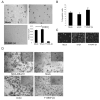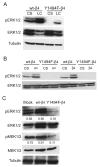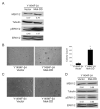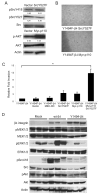A key tyrosine (Y1494) in the beta4 integrin regulates multiple signaling pathways important for tumor development and progression
- PMID: 18974120
- PMCID: PMC2586898
- DOI: 10.1158/0008-5472.CAN-08-2125
A key tyrosine (Y1494) in the beta4 integrin regulates multiple signaling pathways important for tumor development and progression
Abstract
Expression of the alpha6beta4 integrin is associated with poor patient prognosis and reduced survival in a variety of human cancers. In recent years, a limited number of in vivo studies have examined the contribution of this integrin receptor to cancer progression and they have revealed that the alpha6beta4 integrin plays a multifaceted role in regulating tumor development and progression. In the current study, we investigated the mechanism by which one tyrosine residue in the beta4 subunit cytoplasmic domain, Y1494, contributes to the tumor-promoting functions of the alpha6beta4 integrin in vivo. We show that Y1494 participates in the stimulation of diverse signaling pathways that promote alpha6beta4-dependent tumor growth and invasion. Mutation of Y1494 inhibits the ability of the alpha6beta4 integrin to support anchorage-independent growth in vitro and tumor development and angiogenesis in vivo, a result that mimics the loss of total expression of the beta4 subunit. Our results support the hypothesis that Y1494 regulates alpha6beta4-dependent anchorage-independent growth through activation of the extracellular signal-regulated kinase 1/2 signaling pathway, and invasion through the combined activation of phosphatidylinositol 3-kinase and Src. Collectively, our results identify Y1494 as a major regulatory site for signaling from the alpha6beta4 integrin to promote tumor development and progression.
Figures





Similar articles
-
SHP2 mediates the localized activation of Fyn downstream of the α6β4 integrin to promote carcinoma invasion.Mol Cell Biol. 2010 Nov;30(22):5306-17. doi: 10.1128/MCB.00326-10. Epub 2010 Sep 20. Mol Cell Biol. 2010. PMID: 20855525 Free PMC article.
-
Integrin (alpha6beta4) signals through Src to increase expression of S100A4, a metastasis-promoting factor: implications for cancer cell invasion.Mol Cancer Res. 2009 Oct;7(10):1605-12. doi: 10.1158/1541-7786.MCR-09-0102. Epub 2009 Oct 6. Mol Cancer Res. 2009. PMID: 19808905
-
Identification of insulin receptor substrate 1 (IRS-1) and IRS-2 as signaling intermediates in the alpha6beta4 integrin-dependent activation of phosphoinositide 3-OH kinase and promotion of invasion.Mol Cell Biol. 2001 Aug;21(15):5082-93. doi: 10.1128/MCB.21.15.5082-5093.2001. Mol Cell Biol. 2001. PMID: 11438664 Free PMC article.
-
Clinical significance of the integrin α6β4 in human malignancies.Lab Invest. 2015 Sep;95(9):976-86. doi: 10.1038/labinvest.2015.82. Epub 2015 Jun 29. Lab Invest. 2015. PMID: 26121317 Free PMC article. Review.
-
Roles of laminin-332 and alpha6beta4 integrin in tumor progression.Mini Rev Med Chem. 2009 Oct;9(11):1284-91. doi: 10.2174/138955709789878114. Mini Rev Med Chem. 2009. PMID: 19929806 Review.
Cited by
-
Netrin-1 suppresses the MEK/ERK pathway and ITGB4 in pancreatic cancer.Oncotarget. 2016 Apr 26;7(17):24719-33. doi: 10.18632/oncotarget.8348. Oncotarget. 2016. PMID: 27034160 Free PMC article.
-
Phosphosignature predicts dasatinib response in non-small cell lung cancer.Mol Cell Proteomics. 2012 Sep;11(9):651-68. doi: 10.1074/mcp.M111.016410. Epub 2012 May 21. Mol Cell Proteomics. 2012. PMID: 22617229 Free PMC article.
-
SHP2 mediates the localized activation of Fyn downstream of the α6β4 integrin to promote carcinoma invasion.Mol Cell Biol. 2010 Nov;30(22):5306-17. doi: 10.1128/MCB.00326-10. Epub 2010 Sep 20. Mol Cell Biol. 2010. PMID: 20855525 Free PMC article.
-
Candidate early detection protein biomarkers for ER+/PR+ invasive ductal breast carcinoma identified using pre-clinical plasma from the WHI observational study.Breast Cancer Res Treat. 2015 Sep;153(2):445-54. doi: 10.1007/s10549-015-3554-5. Epub 2015 Aug 30. Breast Cancer Res Treat. 2015. PMID: 26319120 Free PMC article.
-
SYK interaction with ITGβ4 suppressed by Epstein-Barr virus LMP2A modulates migration and invasion of nasopharyngeal carcinoma cells.Oncogene. 2015 Aug 20;34(34):4491-9. doi: 10.1038/onc.2014.380. Epub 2014 Dec 22. Oncogene. 2015. PMID: 25531330
References
-
- Falcioni R, Sacchi A, Resau J, Kennel SJ. Monoclonal antibody to human carcinoma-associated protein complex: quantitation in normal and tumor tissue. Cancer Res. 1988;48(4):816–21. - PubMed
-
- Van Waes C, Kozarsky KF, Warren AB, et al. The A9 antigen associated with aggressive human squamous carcinoma is structurally and functionally similar to the newly defined integrin alpha 6 beta 4. Cancer Res. 1991;51(9):2395–402. - PubMed
-
- Falcioni R, Turchi V, Vittulo P, et al. Integrin beta 4 expression in colorectal cancer. International Journal of Oncology. 1994;5:573–8. - PubMed
-
- Tagliabue E, Ghirelli C, Squicciarini P, Aiello P, Colnaghi MI, Menard S. Prognostic value of alpha 6 beta 4 integrin expression in breast carcinomas is affected by laminin production from tumor cells. Clin Cancer Res. 1998;4(2):407–10. - PubMed
-
- Lu S, Simin K, Khan A, Mercurio AM. Analysis of integrin beta4 expression in human breast cancer: association with basal-like tumors and prognostic significance. Clin Cancer Res. 2008;14(4):1050–8. - PubMed
Publication types
MeSH terms
Substances
Grants and funding
LinkOut - more resources
Full Text Sources
Other Literature Sources
Miscellaneous

